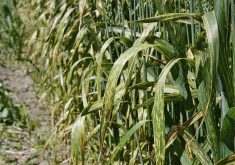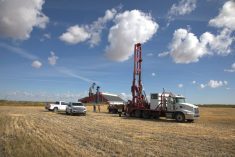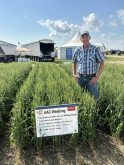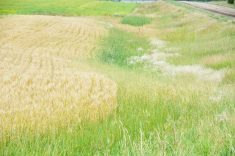As concerns grow over sustainability in modern farming, researchers are looking to the past in search of crops that can both meet the needs of farmers and consumers as well as the environment.
Thinopyrum intermedium — commonly known as intermediate wheatgrass — is one of the fruits of that research.
It’s been nearly three decades since researchers at The Rodale Institute in Pennsylvania launched the effort to develop a perennial wheat. They first surveyed perennial grasses and plants to find the best ones to domesticate and then bred lines of intermediate wheatgrass to produce larger seeds, higher yields, and other agronomic attributes. The research then began getting spread around to places like The Land Institute in Kansas, the University of Minnesota, the University of Manitoba, and Agriculture and Agri-Food Canada’s Lethbridge Research Centre.

“I have some of that material out in the field that I’m evaluating from an agronomy crop usage perspective,” said Jamie Larsen, a cereals breeder at the centre. “But I’m also using that material to cross with wheat to produce perennial wheat.”
There’s still some distance to cover before that goal is achieved, but it’s getting closer.
“This year will be our first harvest testing them in row plots to look at yield potential on a larger scale,” said Doug Cattani, a University of Manitoba crop researcher who helped bring intermediate wheatgrass to Canada.
“Right now, we’re looking at 500 to 600 pounds per acre, however, the lines we’re producing from are not the best we have for seed production.”
That’s a small fraction of what an acre of wheat produces but intermediate wheatgrass can produce for three or four years before there’s a noticeable drop-off in yield, said Larsen.
And, of course, you can’t graze a wheat field in the spring and harvest a crop off it in the summer.
“There’s a real range of benefits beyond a winter annual,” said Larsen. “After you take the crop off, there are a lot of growing days left that a perennial can grow rather than leaving the field bare until the spring. It’s a competitive plant that can inhibit weeds germinating in the fall.”

Another benefit is the increased ability to use intermediate wheatgrass fields as rotational pasture.
Larsen said the way he sees it working is seeding in the fall and allowing the plants to establish before turning livestock onto the field. The livestock can graze until the plant stops growing for the winter. Once spring arrives, the wheatgrass greens up earlier than native pasture, so livestock can be grazed earlier. (However, grazing in the spring needs to be done lightly and livestock must be pulled off before any damage is done to the main stalks, as this can affect yields as well as the longevity of the plant.)
“Once you include a grain harvest with grazing in the fall and the spring, you have the most economically viable farming method,” Larsen said.
Read Also

Grazing ‘sweet spot’ boosts pasture performance
Timing-focused approach to pasture management touted to boost forage growth, livestock gains while also cutting farmer labour and inputs
And there is potential for boosting yields, too.
A lot of Cattani’s work over the past five years has been in finding plants that can survive the severe temperature swings of a Canadian Prairie spring, he said.
“In 2012, we had 20 C days in mid- to late March, and then with a -9.5 C day in early April, approximately 40 per cent of the plants suffered some sort of damage and many did not produce,” Cattani said.
How long perennial wheatgrasses can remain economically viable is “the $24-million question,” said Larsen.
“We’ve only had good varieties to test with in the past three to four years, so there’s not a lot of research,” he said.
Cattani is looking to start developing large-scale research plots within the next few years to look at long-term production and viability.
But even though commercial production is years away, there’s already a growing interest in the crop from companies, such as General Mills, that are developing sustainability strategies, he said.
“Commercial usage envisioned over the next 20 to 30 years is most likely a sourdough type of bread,” said Cattani, adding it needs to ferment rather than rise with yeast.
But several U.S. restaurants are serving the grain in a fashion similar to naked oats and Prairie rice. There’s been success in using it as a pancake mix or blended with wheat flour for muffins as well, he said.
But farmers looking to get in on the ground floor may need to wait a little longer.
“At this point there’s no seed available on the market,” Cattani said. “It’s not too far away, but we’re not there yet.”















